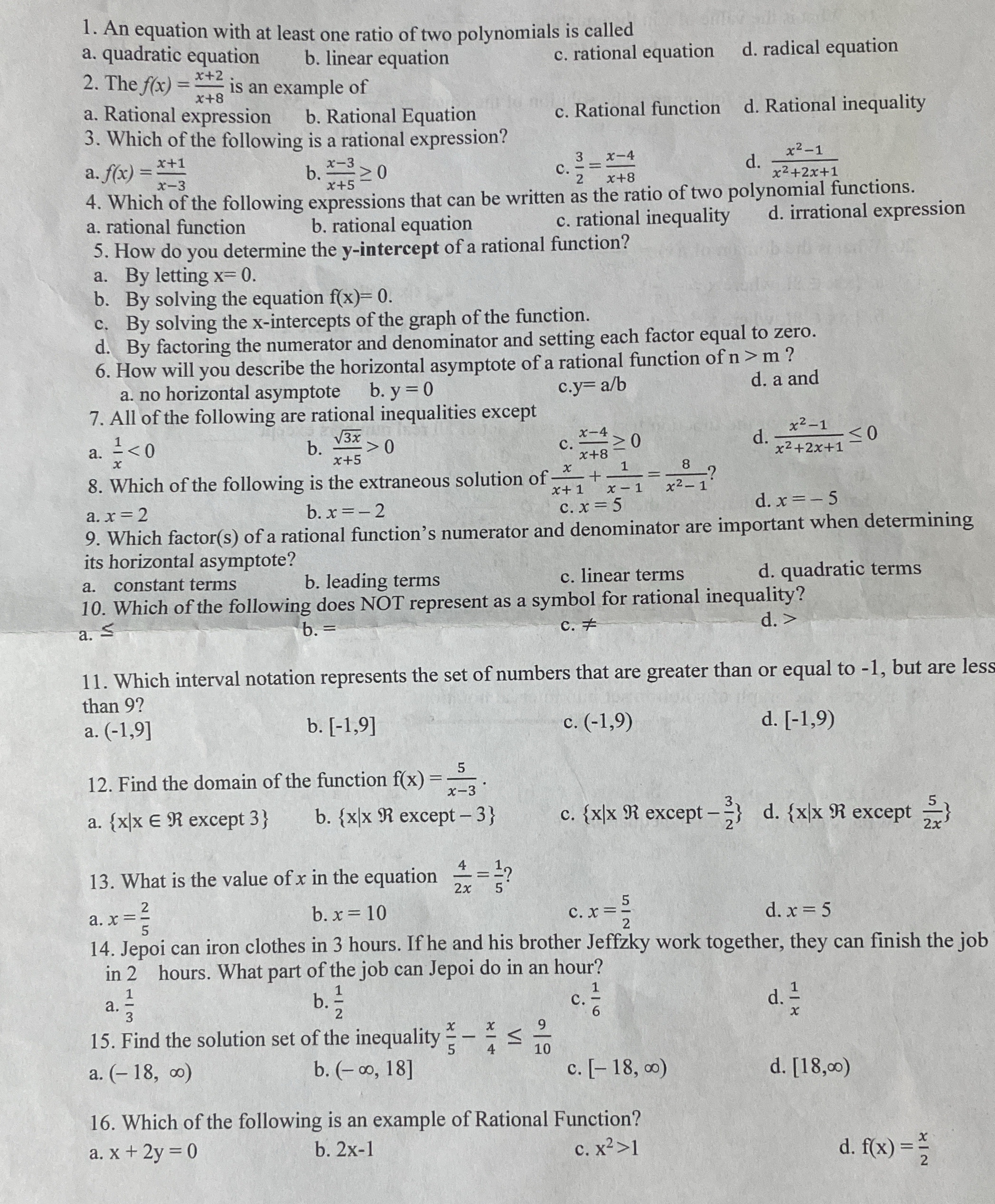1. An equation with at least one ratio of two polynomials is called a. quadratic equation b. linear equation c. rational equation d. radical equation 2. The f(x) = (x^2 + 2)/(x + 8... 1. An equation with at least one ratio of two polynomials is called a. quadratic equation b. linear equation c. rational equation d. radical equation 2. The f(x) = (x^2 + 2)/(x + 8) is an example of a. Rational expression b. Rational Equation c. Rational function d. Rational inequality 3. Which of the following is a rational expression? a. f(x) = (x + 1)/(x - 3) b. (x - 3)/(x + 5) ≥ 0 c. (3)/(x^4) d. (x^2 - 2x + 1)/(x^2) 4. Which of the following expressions that can be written as the ratio of two polynomial functions. a. rational function b. rational equation c. rational inequality d. irrational expression 5. How do you determine the y-intercept of a rational function? a. By letting x = 0. b. By solving the equation f(x) = 0. c. By solving the x-intercepts of the graph of the function. d. By factoring the numerator and denominator and setting each factor equal to zero. 6. How will you describe the horizontal asymptote of a rational function of n > m? a. no horizontal asymptote b. y = 0 c. y = a/b d. a and 7. All of the following are rational inequalities except a. 1/x < 0 b. √(3x)/(x + 5) > 0 c. x/(x + 1) - 8 < -1 d. x/(x^2 - 2) ≤ 0 8. Which of the following is the extraneous solution of x/(x + 1) = 1/(x^2 - 1)? a. x = 2 b. x = -2 c. x = 5 d. x = 5 9. Which factor(s) of a rational function's numerator and denominator are important when determining its horizontal asymptote? a. constant terms b. leading terms c. linear terms d. quadratic terms 10. Which of the following does NOT represent a symbol for rational inequality? a. ≤ b. = c. ≠ d. > 11. Which interval notation represents the set of numbers greater than or equal to -1, but less than 9? a. (-1, 9) b. [-1, 9] c. (-1, 9) d. [-1, 9] 12. Find the domain of the function f(x) = (5)/(x - 3). a. {x|x ∈ ℝ except 3} b. {x|x ∈ ℝ except -3} c. {x|x ∈ ℝ except -3/2} d. {x|x ∈ ℝ except 5/2} 13. What is the value of x in the equation (4)/(2x) = (1)/(5)? a. x = 5/2 b. x = 10 c. x = 5/2 d. x = 5 14. Jepoi can iron clothes in 3 hours. If he and his brother Jeffzky work together, they can finish the job in 2 hours. What part of the job can Jepoi do in an hour? a. 1/3 b. 1/2 c. 1/6 d. 1/x 15. Find the solution set of the inequality (5)/(x - 4) < (9)/(10). a. (-18, ∞) b. (-∞, 18) c. [-18, ∞) d. [18, ∞) 16. Which of the following is an example of Rational Function? a. x + 2y = 0 b. 2x - 1 c. x^2 > 1 d. f(x) = (x)/(2).

Understand the Problem
The question set includes various problems related to rational functions, inequalities, and interval notation. Specific questions ask about definitions, solving equations, graphing, and identifying elements of rational expressions.
Answer
The rational function is $f(x) = \frac{5}{-3}$; domain is ${x \in \mathbb{R}}$, interval notation is $(-\infty, 9)$, and solution to the inequality $\frac{x}{5} - \frac{x}{4} < \frac{9}{10}$ is $x > -18$.
Answer for screen readers
-
$f(x) = \frac{5}{-3}$ is a rational function.
-
Domain is ${x \in \mathbb{R}}$.
-
The interval notation is $(-\infty, 9)$.
-
Solution to the inequality $\frac{x}{5} - \frac{x}{4} < \frac{9}{10}$ is $x > -18$.
Steps to Solve
- Identify the rational function type
The function is given as $f(x) = \frac{5}{-3}$. This is a rational function, which is a ratio of polynomials.
- Understanding the terms
Rational expressions are of the form $\frac{P(x)}{Q(x)}$ where $P(x)$ and $Q(x)$ are polynomials. This matches the definition of a rational function.
- Solving for the domain
To find the domain of the function $f(x) = \frac{5}{-3}$, we look for values that make the denominator zero. Since $-3 \neq 0$, the domain is all real numbers. We can express this as ${x \in \mathbb{R}}$.
- Evaluate interval notation
Next, for the question on interval notation that represents numbers between 9 and other bounds, the notation to use is $(-\infty, 9)$.
- Solve the inequalities
For the inequality $\frac{x}{5} - \frac{x}{4} < \frac{9}{10}$, combine the fractions: $$ \frac{4x - 5x}{20} < \frac{9}{10} $$ Simplifying gives $-\frac{x}{20} < \frac{9}{10}$. This leads to $x > -18$ after multiplying by -20 (reversing the inequality).
-
$f(x) = \frac{5}{-3}$ is a rational function.
-
Domain is ${x \in \mathbb{R}}$.
-
The interval notation is $(-\infty, 9)$.
-
Solution to the inequality $\frac{x}{5} - \frac{x}{4} < \frac{9}{10}$ is $x > -18$.
More Information
Rational functions are essential in algebra and calculus, exhibiting unique behaviors depending on their polynomials. Understanding their intervals and domains is critical for analysis and graphing.
Tips
- Forgetting to exclude points that cause the denominator to be zero when determining domain.
- Mixing up interval notation; for example, using brackets instead of parentheses where endpoints aren't included (e.g., $(-\infty, 9)$ not $[-\infty, 9]$).
AI-generated content may contain errors. Please verify critical information